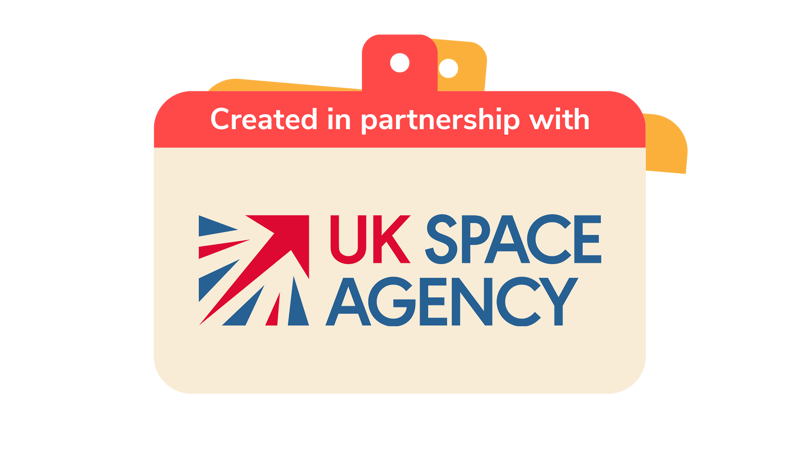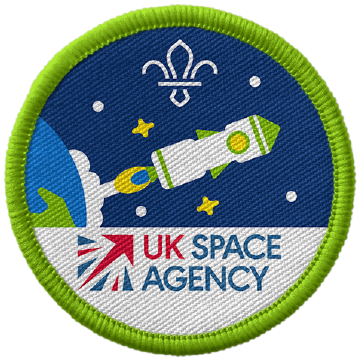
Make teddy space helmets
You’ll need
- Scissors
- Glue sticks
- Sticky tape
- Tin foil
- Small cardboard tissue boxes (tissue boxes work well)
- Toilet roll or kitchen roll cardboard tubes
- Craft materials to decorate (such as stickers, pipe cleaners, plastic bottle tops or scrap paper)
Before you begin
- Use the safety checklist to help you plan and risk assess your activity. There's also more guidance to help you carry out your risk assessment, including examples. Don’t forget to make sure all young people and adults involved in the activity know how to take part safely.
- Make sure you’ll have enough adult helpers. You may need some parents and carers to help if you’re short on helpers.
Planning this activity
- Let everyone know that they’ll need to bring in a teddy or toy for this session. It might be a good idea to bring some spare teddies if you can, in case someone forgets to bring theirs.
- You may want to pre-cut some boxes in advance. You’ll need to cut a square or circle shape out of one side of each box, so you can see the teddies’ faces.
Story time
If you want to, gather everyone together in a circle and tell a story about a bear or teddy going into space. You could read one of the suggested books on this page or create your own story. You could also use a teddy as a prop to tell the story.
After finishing the story, everyone should take some time to reflect on it as a group. You could use these questions to help you reflect:
- How do you think the teddy was feeling as they went on their adventure?
- What did they need to take with them? Why do you think this was?
- What would your teddy need to keep them safe and help them on their space adventure?
You can choose your own book to read, ask young people to bring one in, or borrow a book from a library. If you don’t have a physical copy of a book, you can often find a video of someone reading the book online.
Our suggested stories are:
- Whatever Next! by Jill Murphy
- Ted’s Space Adventure by Elizabeth Avery
Instead of using a book, you could use this simple story starter and key questions to create your own story with the group, such as ‘One night, Teddy crept out of his bed and saw the big, bright moon through the window. It looked amazing. He knew he had to find a way to get there!’
You can then ask these questions to get everyone to create the rest of the story:
- What should Teddy do next?
- How will he get to the moon?
- What will he need to wear?
- Where will he get it from?
Make the space helmets
- Gather everyone together in a circle and explain that you’re going to make space helmets for your teddies to go on their own adventure.
- Ask everyone why they think astronauts need space helmets and space suits. Space helmets and space suits help astronauts in many ways. They protect astronauts from getting too hot or cold. They also give astronauts oxygen to breathe while they’re working in space.
- Pick up your teddy and find a box which will fit on the top of their head.
- Everyone should take time to find the right sized box for their teddy. If a box is too big, people could carefully, with an adult’s help, use scissors to cut their box and tape it back into a helmet shape.
- Next, people should cover their cardboard box in tin foil. You should be able to scrunch it up and fold it over the sides of the box to keep it in place. You can also stick it in place with a glue stick or sticky tape.
- After the tinfoil has been added, everyone should decorate their teddy’s helmet. They could add stickers, colour the tinfoil with felt tips, write their teddy’s name, add plastic bottle top buttons or use some pipe cleaners for antennae. People can be really creative!
- Finally, put the helmets onto the teddies, so that they’re ready for their space adventure.
- You could ask those who are happy to introduce their astronauts and show off their helmets. You could have a fashion show to show off the helmets, set up a space obstacle course for the teddies to complete, or have a space relay race with the teddies.
- An astronaut is a person who travels into space. Some animals have been to space too, including monkeys, frogs and jellyfish!
- You need to do lots of training for a long time to become an astronaut. Did you know that astronauts do some of their training underwater?
- The longest time an astronaut has spent in space is a whole 437 days.
- Astronauts travel into space in a spacecraft, such as rocket. For a rocket to get into orbit around Earth, it needs to travel 17,600 miles per hour!
- If you wanted to go even further into space, out of Earth’s gravity, then you would need to travel even faster. Sometimes up to 25,000 miles per hour!
- Some Astronauts live and do science experiments onboard a space station called the International Space Station or ISS. You can sometimes look up from Earth and see the International Space Station passing by in the night sky.
- One of the astronauts who’s been to the International Space Suit is Tim Peake. Did you know he’s one of our Scout Ambassadors?
- Astronauts use lots of special equipment, such as spacesuits. Space is very cold and is around -270.45 Celsius. Luckily space suits are very well insulated to keep the astronauts warm in the cold conditions. There’s not really any oxygen in space too, so a spacesuit gives astronauts oxygen, so they can breathe.
- Did you know that it is completely silent in space? There’s no way for sound to travel. Luckily, astronauts can speak to each other and people on Earth using their radios as the radio waves are still able to travel.
- On our planet, Earth, there’s a special force called gravity. It keeps us on the ground and stops us floating away. The gravity on the Moon is just one-sixth of the Earth’s, so you would weigh less on the Moon. You could jump higher and carry much heavier things too!
- You wouldn’t be able to walk on Jupiter, Saturn, Uranus or Neptune because they have no solid surface like we do on Earth.
- Some astronauts can become a bit taller when they go to space. After they’ve landed back on Earth, they slowly go back to their normal height.
- It takes about three days to get to the moon. If you could fly a plane to Pluto, the trip would take more than 800 years!
- Neil Armstrong was the first human to walk on the moon in 1969. He completed the mission alongside co-pilots Edwin E. “Buzz” Aldrin and Michael Collins. Did you know, 11 of the 12 people who’ve walked on the Moon were Scouts?
Reflection
This activity was all about space. What did you find out about space and astronauts? Can you remember why a space helmet and space suit is important for an astronaut?
We made our teddies into astronauts. What do you think our teddies would see in space? What was it like making the space helmet? What did you include or add to your helmet? Did your teddy like your helmet? And did it suit them? Is there anything else you’d like to add to your helmet?
Safety
All activities must be safely managed. You must complete a thorough risk assessment and take appropriate steps to reduce risk. Use the safety checklist to help you plan and risk assess your activity. Always get approval for the activity, and have suitable supervision and an InTouch process.
- Scissors
Supervise young people appropriately when they’re using scissors. Store all sharp objects securely, out of the reach of young people.
- Rubbish and recycling
All items should be clean and suitable for this activity.
- Glue and solvents
Always supervise young people appropriately when they’re using glue and solvent products. Make sure there’s plenty of ventilation. Be aware of any medical conditions that could be affected by glue or solvent use and make adjustments as needed.
- To make this activity easier, you could use photos and books to look at what astronauts wear. Pre-cutting the boxes and pre-tearing the tin foil into smaller pieces can make it easier too.
- To make this activity harder, see if people can they design a full outfit to help teddy survive in space and explain what each item does.
- Arts and crafts activities can be done sitting or standing – whichever way works best for everyone. Make sure that all the materials are at a level that can easily be collected by and worked on by wheelchair users.
- Some arts and craft activities may involve touching certain textures or items or involve getting messy. People should only do this if they’re comfortable too. People could wear plastic gloves if they don’t like the feeling of a certain material on their hands. They could also use another method of being creative, such as by making a tissue paper collage or using paint to avoid touching the material.
- If people struggle with the cutting in this activity, some materials (such as the cups and tissue paper) can be pre-cut for people to use.
- If anyone needs help or struggles with fine motor skills, give them the opportunity to work in pairs or small groups. They could also work with a young leader or an adult volunteer. The person they’re working with can help with the parts they find fiddly to do or tricky.
- People could use adaptive equipment or different materials if needed, such as left-handed scissors, thicker or thinner paper, or pencil grips.
All Scout activities should be inclusive and accessible.
You could use the astronaut teddies to roleplay exploring space and hide pretend ‘space rock’ beanbags for people to try to find. You could also make a space helmet or space suit for someone in your group to wear, or design your own space suits on paper.
Create a story together at the start of the session using a teddy as a prop. As a group, explore what your teddy is like, why they’re going to space and how they’re going to get there. Involve everyone in deciding the small details of the story and what happens next. Encourage everyone to think about their own teddies’ stories and how this will change what they might need to wear to travel to space.
